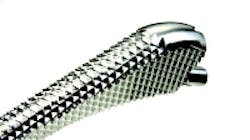Shop Multitasks Its Way To Medical
Micropulse wins more medical work with its Schütte linear grinder equipped with a Siemens CNC and drive package. Instead of using separate machines, Micropulse generates complex hip broach surfaces (top) on one machine and in a single setup
Several factors present special challenges to shops that supply machined metal parts to medical markets, but none is as daunting as making a profit on low-volume jobs. While most shops will use several strategies to overcome the challenge, one medical-parts supplier — Micropulse Inc. — concentrates on two: The introduction of more automation into its processes and the acquisition of more sophisticated machine tools capable of performing multiple functions.
Micropulse (www.micropulseinc.com) has designed and built a number of dedicated automation devices such as auto-advance tooling for automatically going from one electrode to the next on its sinker EDMs. Sinker EDMs are the primary machine tools the shop uses. "Just making a great part and delivering it on time isn't enough. Advancements we've made in automation have substantially reduced our time-to-part and our own cost structures, while maintaining the highest quality possible," says Randy Sible, sales engineer at Micropulse.
For its machine tools, Sible says the company recently was exploring new markets in which its current machine tool mix was not able to help it to win business at competitive and profitable prices. During that exploration, the shop found a WU 305 Linear universal tool and cutter grinder from Schütte USA LLC (www.schuttetgm.com) that combines milling, grinding, belt sanding and polishing on one pendulum slide with a CNC rotary axis.
"The machine isn't simply a glorified tool changer because it has true five-axis capability and is touted for form tool production where both axial and radial clearance angles are critical. We perform all these functions on our parts, but mostly on individual machine tools," Sible says. However, the practice is too costly when part complexity reaches certain levels, as with knee joint or hip broaches (a surgical tool used to prepare hip joints for implant procedures).
The machine has rigidity and precision, a small footprint and a coolant-filtration system, and Sible says its Sinumerik 840D CNC from Siemens Energy & Automation Machine Tool Business (www.siemenscnc.com) provides the flexibility and open architecture needed to drive all of its functions. The CNC also lets Micropulse manage the proprietary part design and machining programs it and its customers use. Additionally, the machine incorporates Siemens linear motors, instead of ballscrews, on its five axes. Sible says that gives it improved uptime while requiring less maintenance.
Brian Emerick, president of Micropulse, said he realized early on that the machine would pave the way for entering the markets for knee joint, hip broach and other end products in which the shop was not competitive previously. He was proven right. Within the first year after it was installed, the linear grinder helped the shop to achieve substantial gains in business from old and new customers.
In operation, the machine's CNC provides lockout keys that limit function access, so there is no chance of changing the machine functions or the software on the cutting program, except by the operator and other select individuals at Micropulse. This is important to the shop because of the expensive materials it runs and the highly proprietary nature of customer parts.
Also, Sible says the Siemens control and drive package work together to maintain machine speed and accuracy. Its large look-ahead feature keeps speeds optimized, while its hard and soft setup times are reduced because of the integration software and plain language inputs, he says.
